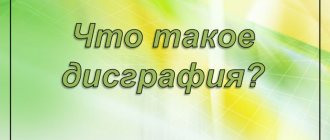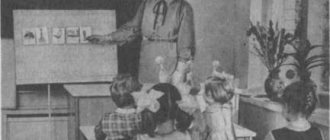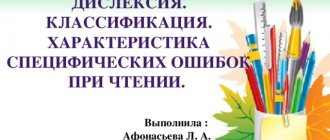Dysgraphia due to impairment of language analysis and synthesis. Symptoms, correction
Bystrova Margarita
Dysgraphia due to impairment of language analysis and synthesis. Symptoms, correction
The mechanism of this type of dysgraphia is a violation of the following forms of language analysis and synthesis :
analysis of sentences into words, syllabic and phonemic analysis and synthesis .
The lack of structure in the analysis of sentences into words is revealed in the continuous spelling of words, especially prepositions;
in separate spelling of words; especially prefixes and roots.
Pr-r: Letam parekhe and blow parhodi.
The most common errors in this type of dysgraphia are distortion of the sound-letter structure of a word, caused by underdevelopment of phonemic analysis , which is the most complex form of sound analysis .
The most common mistakes:
1. omission of consonants when they come together (dozhi-rain, deki-denki)
2. vowel omissions (girls-girls, go-go, dot-dot)
3. permutations of letters (doll-doll, droplets-droplets)
4. adding letters (spring-spring)
5. omissions, additions, rearrangements of syllables (bicycle-bicycle)
.
Teaching literacy in Russian is carried out using the so-called sound analytical-synthetic method , therefore, to master it, the child must be well versed in the sound composition of words, that is, master phonemic analysis and synthesis of words . Of all types of analysis of speech flow : dividing sentences into words, words into syllables and words into sounds, the most difficult for children is the last one - phonemic analysis of words .
A complete phonemic analysis of a word means the ability to divide an audible word into its constituent sounds, that is, to clearly imagine its sound structure. In particular, the child must be able to determine: which sounds (phonemes)
are part of the word; how many sounds are there in a word? what is the sequence of sounds in a word (what sound is first, second, last, etc.; what is the place of each sound in a word in relation to other sounds of this word.
Phonemic synthesis is understood as the ability to combine individual sounds into a whole word with subsequent recognition of this word, mentally “composed” of sounds.
Only if the child has free orientation in the sound composition of a word will he be able to write it down correctly: without omitting any letters in it, without inserting extra letters or changing their places. Indeed, in the process of recording a word, he, as it were, photographically transfers its sound composition onto paper, sequentially depicting each sound included in the word in the form of a corresponding letter. If the sound structure of a word is quite “vague” for a child, then its distortion in writing will be inevitable - there will be omissions and rearrangements of letters or the addition of extra letters, that is, dysgraphia arises due to the immaturity of phonemic analysis and synthesis .
Dysgraphia due to the immaturity of sound analysis and synthesis of speech flow is one of the leading dysgraphias among schoolchildren .
This form of dysgraphia is based on a violation of various forms of language analysis and synthesis : dividing sentences into words, syllabic and phonemic analysis and synthesis . The underdevelopment of language analysis and synthesis manifests itself in writing in distortions of the structure of words and sentences. The most complex form of language analysis is phonemic analysis . As a result, distortions of the sound-letter structure of the word will be especially common in this type of dysgraphia , which is expressed in the following:
omissions of consonants when they come together (dictation - dikat, school - cola)
;
vowel omissions (dog - sbaka)
;
adding letters (toskali - tosakali)
;
omissions, additions, rearrangements of syllables;
continuous spelling of words, especially prepositions with other words;
separate spelling of a word;
separate spelling of the prefix and the root of the word.
the causes of dysgraphia in students in speech underdevelopment, immaturity of mental functions and difficulties in the sound analysis of words .
Dysgraphia is a partial disorder of the writing process , manifested in persistent, repeated errors caused by the immaturity of the higher mental functions involved in the writing process.
Dysgraphia makes up a significant percentage of other speech disorders found in students of secondary schools. It is a serious obstacle to students’ mastery of literacy at the initial stages of education, and at later stages to mastering the grammar of their native language .
In modern literature, various terms are used to refer to specific writing disorders. Partial writing impairments are called dysgraphia , complete inability to write is called agraphia.
In a number of countries (for example, in the USA),
reading and writing disorders “dyslexia”
.
In other countries, specific writing disorders “dysorthography” (for example, in France)
.
In Russian literature, the terms “ dysgraphia ”
and
“dysorthography”
are contrasted, i.e., differentiated.
For differential diagnosis of these disorders, it is necessary to clarify the criteria on the basis of which errors in dysgraphia and dysorthography . This main criterion is the spelling principle that is predominantly violated . It is known that the following basic principles are distinguished in Russian orthography:
phonetic (phonemic,
morphological,
traditional.
Based on phonetic (phonemic)
The principle of spelling lies in the sound
(phonemic) analysis of speech .
Words are written as they are heard and pronounced (house, grass, ditch)
.
The writer analyzes the sound composition of the word and denotes sounds with certain letters. Thus, to implement the phonemic principle of writing, the formation of phoneme differentiation and phonemic analysis .
The morphological principle is that the morphemes of words (root, prefix, suffix, ending)
with the same meaning they also have the same spelling, although their pronunciation in the strong and weak positions may be different (house - do
(a)
mA, table - hundred
(a)
ly).
The use of the morphological principle presupposes the ability to identify meaningful morphemes of a word, determine the morphological structure of a word, and identify morphemes with the same meaning, the pronunciation of which may differ in different phonetic conditions. The level of development of morphological analysis is closely related to the development of vocabulary and grammatical structure of speech.
And finally, the traditional principle assumes a spelling of a word that has developed in the history of the development of writing and cannot be explained by the phonetic or morphological principle of spelling.
Symptoms
According to the definition of the term " dysgraphia "
The following features of errors in
dysgraphia :
1. As with dyslexia, errors in dysgraphia are persistent and specific, which makes it possible to distinguish these errors from “growth”
,
“physiological” (according to B. G. Ananyev)
errors that naturally occur in children when mastering writing.
It should be noted that errors in dysgraphia are similar in appearance to so-called physiological errors. However, in dysgraphia these errors are more numerous, repeated and persist for a long time.
2. Dysgraphic errors are associated with the immaturity of higher mental functions involved in the writing process - differentiation of phonemes by ear and in pronunciation, analysis of sentences into words, syllabic and phonemic analysis and synthesis , lexico-grammatical structure of speech, optical-spatial functions.
Violation of elementary functions ( analyzer )
may also lead to
writing impairments . But these disorders are not considered dysgraphia .
Writing impairment in children (for example, with mental retardation)
may be associated with pedagogical neglect, with
violations of attention and control, which disorganize the entire process of writing as a complex speech activity. However, in this case, errors, if they are not associated with the immaturity of higher mental functions, are not specific, but variable in nature and therefore are not dysgraphic .
3. Errors in dysgraphia are characterized by a violation of the phonetic principle of writing, i.e. errors are observed in a strong phonetic position (lopada - instead of a shovel, dm - house, in contrast to spelling errors, which are observed only in a weak phonetic position (vadyanoy - water, lady - Houses)
.
4. Errors are characterized as dysgraphic when they are observed in school-age children.
In preschool children, writing is accompanied by numerous errors, similar in nature and manifestation to dysgraphic ones . However, in preschool children, many of the mental functions that support the writing process are not yet sufficiently formed. Therefore, these errors are natural, “physiological”
.
The following groups of errors in dysgraphia :
1. Distorted spelling of letters (for example, e - s, s - e)
2.Replacement of handwritten letters:
a) graphically similar (e.g., c – d, l – m, c – sch)
b) denoting phonetically similar sounds (eg, d - t, b - p, g - k)
3. Distortion of the sound-letter structure of a word: permutations, additions, perseveration, contamination of letters, syllables (for example, spring - spring, stana - country, kulbok - ball)
.
4. Distortion of the structure of the sentence: separate spelling of words, continuous spelling of words, contamination of words (for example, rooks fly from the warm countries)
.
5. Agrammatisms in writing (eg, a lot of pencils, no keys, on branches)
.
Correction
Dysgraphia due to a violation of language analysis and synthesis manifests itself in writing in the omission of consonant letters when they are combined, omission of vowels, rearrangements and additions of letters; omissions, rearrangements and additions of syllables, continuous spelling of words and their breaks. The most complex form of language analysis is phonemic . Particularly common in this type of dysgraphia are distortions of the sound-letter structure of words among primary school students in public schools.
Therefore, the process of dysgraphia correction includes the following steps:
1. Correction of defective sounds (additionally by a speech therapist if such a complication exists)
;
2. With a Russian language using special techniques:
Formation of phonemic perception and attention to words when reproducing oppositional phonemes in writing;
Formation of sound-letter analysis ;
Word synthesis;
Development of abilities to analyze and synthesize words ;
Development of abilities to construct phrases and coherent statements, writing tempo;
Expanding vocabulary.
To correct dysgraphia in younger schoolchildren, it is necessary to carry out strictly targeted work with them for quite a long time and always using a large amount of carefully selected speech material of the same type. To correct dysgraphia in Russian language lessons, you can use the following exercises:
1) Exercise “ Proofreading ”.
For this exercise you need a book, boring and with a fairly large (not small)
font.
works
every day for five (no more) You need to start with one letter, for example, “a”. Then “o”, then the consonants with which there are problems, first they also need to be asked one at a time. After 5-6 days of such classes, we switch to two letters, one is crossed out, the other is underlined or circled. The letters should be “paired”, “similar” in the student’s mind. For example, as practice shows, most often difficulties arise with the pairs “p/t”, “p/r”, “m/l” (spelling similarity)
; “y/d”, “y/y”, “d/b” (in the latter case the child forgets whether the tail of the circle is pointing up or down), etc.
The pairs required for development can be established by viewing any text written by the child. After seeing the correction, ask what letter he wanted to write here. More often than not, everything is clear without explanation.
It’s better if the text is not read (that’s why the book needs to be boring)
. All attention must be concentrated on finding the given shape of a letter, one or two, and work only with them.
2). Exercise “Sound analysis in the “scanning technique” (the task is performed without first reading the word)
:
look at the word;
look at the middle letter in that word (for example, d in "boat")
;
looking at the middle letter, you will also see the letter on the right (k)
and left
(o)
;
continue the exercise, adding a letter to the right and left until you get the whole word;
name the word.
After you have completed the work with five to ten words, you can conduct an auditory dictation of these words.
It is worth focusing on the students’ violation The control operation over one's own written production must be specially formed. P. Ya. Galperin showed the relationship between control and attention and formulated a hypothesis according to which attention should be considered as a separate independent form of mental activity, which must be specially taught [27].
Attention as a special control function includes several step-by-step operations. P. Ya. Galperin identified three types of control:
anticipatory, i.e. defining the program of “how I will do”;
current, accompanying the recording and implementing the formula: “am I doing as I planned?”;
resultant.
According to P. Ya. Galperin, at school they mainly develop resulting control. When correcting dysgraphia , caused by immaturity of language analysis and synthesis , it is advisable to shift the emphasis to the formation of preliminary and current control and teach how to carry out individual control operations.
The methodological recommendations of the teacher E. N. Ilyin suggest “oral” dictations of words. The student’s attention is concentrated on a specific task, auditory, visual, and motor memory are involved. This type of work can be classified as preliminary control.
Children with dysgraphia due to impaired language analysis and synthesis at a low level perform tasks such as reproducing a sequence of movements, sound and graphic rhythms, make many mistakes when reproducing a sequence of images, have difficulty reproducing the temporal sequence of verbal stimuli (words, numbers, are not able to automation of speech sequences
To develop control over one’s own written production when correcting dysgraphia caused by a violation of language analysis and synthesis , it is advisable to use a system of preliminary exercises.
Here are some examples of preliminary exercises.
1. Look at the sample (shapes, symbols, letters, remember it, then what you remember:
draw with your finger on the desk;
tell;
write in your notebook.
After completing each task, ask to check what was completed with the sample, supplement and clarify. Discuss which implementation was most successful.
2. Exercise to develop skills in analyzing and reproducing spatial sequences:
check if the characters are the same (letters, numbers)
crossed out on the card and sample card;
check whether the pattern is drawn correctly;
remember the card and choose the same one (the child is asked to remember a number of subject pictures, symbols, numbers, letters on the card and find the same one among the second set of cards, only one of which matches the test one);
lay out a series of individual elements from memory;
write a series of individual elements from memory.
After completing each task, ask to check what was completed with the sample, supplement and clarify.
3. Exercise to develop skills in analyzing and reproducing time sequences:
“Charging” - sequence of movements (from 3 to 6)
;
name the days of the week, seasons, months in order (object drawings, symbols, verbally)
;
“balls in an opaque tube” (in front of the children, multi-colored balls are placed into an opaque tube. Task: determine in what sequence they will roll out from the opposite end of the tube). Complicated option: determine in what sequence the balls will roll out from the same end of the tube, in which was nested (this requires inverting the series)
.
4. Recoding the temporal sequence into a spatial one and vice versa - “invisible pictures”.
A number of cards (object drawings, symbols)
. Each card laid out is presented and turned face down. Thus, the laid out row is turned with the back side towards the child, and the front side is closed. From a set of cards with rows of images arranged in different sequences, the child must find one identical to the one laid out. After the choice is made, both series are compared.
5. Development of abilities to concentrate, distribute and switch attention:
“synchronous counting” - count the number of images of two types, without paying attention to the remaining images;
find numbers from 1 to 25 in Schulte tables (the numbers are located in 25 cells in random order)
;
select a specific letter, read the text and cross out the given letter;
select a specific word and read the text, underlining the given word.
6. Sequence of actions and planning.
Games for following multi-step instructions (2, 3, 4, and 5-step instructions)
: by reference symbols, by memory
(verbal instructions)
.
Methods of work on the formation of preliminary control include:
1. Musical method (based on the methodology of L. S. Tsvetkova, promoting the actualization of the meaning of the word, the development of auditory and visual modalities, and self-control.
The speech therapist offers children two or three rhymed sentences set to the tune of a familiar song. The content of each sentence is displayed in a schematic drawing of the object performing the action and the object to which this action is directed. All sentences are sung based on the pictures. Words-objects that have a complex syllable structure are analyzed . Action words are subject to mandatory analysis Scheme of words-actions (first complete, then minimized as much as possible)
remains as a support for writing the sentence.
Using pictures and word diagrams, children sing sentences.
At the next lesson, children listen to a sample of the speech therapist’s singing, while at the same time looking at pictures and diagrams of words. Then write down the sentences from memory using supports (drawings and diagrams)
.
2. Method of rhythmic reading (based on the technique of T. G. Wiesel)
:
read sentences with syllabic rhythm, that is, with the division of words into syllables and their uniform pronunciation in the orthographic version - the way they are written. (The speech therapist taps out the rhythm)
This syllable-by-syllable “orthographic” rhythmic pronunciation of words and phrases is carried out in the following variants:
repeat the rhythmic word (sentence) after the speech therapist, and then write it down;
repeat syllable by ear when the speech therapist pronounces the sentence in the usual way;
“from sight”, read the text rhythmically.
To develop control over your own written production when correcting dysgraphia caused by a violation of language analysis and synthesis , you can use the following techniques of syllabic analysis .
Analysis and diagramming of words
Models of the sound and syllabic structure of a word contain information about the number of syllables, syllable boundaries, vowel sounds are indicated, consonant sounds are indicated, the place of hard and soft signs: updating the meaning of the word; rhythmic repetition of a word; designation of vowel sounds by letters in the word diagram; designation of consonant sounds with dots in the word diagram; designation of the place of hard and soft signs in the word scheme; dividing a word into syllables; reading a word in accordance with the syllable pattern.
After the child has made diagrams of two to five words, which depends on the state of his auditory-verbal memory and age, the syllabic structure of the words, it is necessary to offer to write down the words from memory based on the model of the word. This task allows you to expand the linear volume of the child’s auditory-verbal memory.
Current control.
A letter spoken out loud:
speech therapist (“leading”)
pronounces the lexical material out loud, the student
(“follower”)
writes it down, then the roles change;
pronunciation and simultaneous recording of lexical material by the student.
Words are pronounced out loud, in a whisper, pronouncing only complex words.
Resulting control:
comparison of a text with errors typical for a given child with a normative sample of the text;
independent correction of errors in the text;
cheating followed by self-test (the speech therapist can focus on the line with the error)
;
checking with crossing out syllables, marking vowels with dots;
rhythmic reading of your work.
Word combinations for sound analysis : 2nd grade
Late dinner, strawberry jam, drive slowly, enter the village, explained to a student, interesting story, neat notebook, ran along the alley, walked along the alley, carrot salad, beautiful picture, read in the calendar, bus stop, vociferous nightingale, beautiful nightingale, delicious lunch, today is Sunday, see a plant, warm September, station square, new tram, yellow shoes, rare animals, aspen leaves, hare tracks, rare plant, northern lights, deep space, hot dinner, February cold, goodbye, delicious strawberries, long highway, warm felt boots, a kilogram of tomatoes, white metal, play football, play hockey, turn left, first cosmonaut, interesting fairy tale, write slowly, neat student, metal stairs, grocery store, yellow pencil, wonderful excursion, January frost, passed to the right, light breakfast, solve problems, hello, yellow sand, black crow, sow the field with wheat, tonight, diesel locomotive, walked slowly, attentive driver, slippery highway, potato casserole, distance to the city, highway, bright fire, weather calendar , library book, bring luggage, friend's address, swamp, ahead, telephone conversation, beautiful drawing.
The mentioned correctional, developmental and educational technologies are based on a systematic approach aimed at developing and improving the child’s interfunctional interaction of higher mental functions, the usefulness of which is the key to successful learning.
Knowledge of psychological and neuropsychological methods for diagnosing and correcting L. S. Tsvetkova, N. V. Nizhegorodtseva and V. D. Shadrikov, U. V. Ulienkova and O. V. Lebedeva, A. V. Semenovich, N. Ya. Semago, A. L. Sirotyuk, and other authors, can provide significant assistance when a speech therapist develops his own system of work for correcting dysgraphia in primary schoolchildren [19; 24].
To achieve these goals, you can additionally suggest some working methods and types of exercises (Appendix A)
.
Article:
Experience in the prevention of dysgraphia based on language analysis and synthesis in preschool children - stages of work, games, exercises.
Prevention of dysgraphia based on language analysis and synthesis in preschool children.
In recent years, the number of children encountering various learning difficulties in primary school has increased significantly. The problem of writing and reading disorders is one of the most pressing for school education, since writing and reading turn from a goal into a means of further acquisition of knowledge by students.
Interest in the problems of early detection, prevention and correction of specific writing disorders (Dysgraphia) in children is due to the fact that writing as an activity plays an important role in a person’s life: it stimulates his mental development, provides general educational training, and influences the formation of personality.
Writing impairment is the most common form of speech pathology among primary school students.
Dysgraphia is a specific disorder of written speech, manifested in numerous typical errors of a persistent nature and caused by the lack of formation of higher mental functions involved in the process of mastering writing skills.
The reason for the occurrence of dysgraphia due to a violation of language analysis and synthesis is difficulties in dividing sentences into words, words into syllables, sounds.
Learning to read and write in Russian is carried out using the so-called sound analytical-synthetic method, therefore, in order to master it, the child must be well versed in the sound composition of words. Of all the types of speech flow analysis: dividing sentences into words, words into syllables, words into sounds, the most difficult for children is phonemic analysis of words.
A complete analysis of a word means the ability to divide an audible word into its constituent sounds, i.e., clearly imagine its sound structure, in particular, the child must determine: which sounds (phonemes) are included in the word; how many sounds are there in a word? what is the sequence of sounds in a word (which sound is first, second...), what is the place of each sound in a word in relation to other sounds of this word.
Complete phonemic synthesis is understood as the ability to combine individual sounds into a whole word with subsequent recognition of this word, mentally “composed” of sounds.
Only if the child has free orientation in the sound composition of a word will he be able to write it down correctly: without missing extra letters or changing their sequence.
If the sound structure of a word is quite “vague” for a child, then its distortion in writing will inevitably occur; omissions and rearrangements or the addition of extra letters will appear, i.e. Dysgraphia occurs due to a violation of language analysis and synthesis.
With this type of dysgraphia, there will be distortions in the sound-letter structure of the word, which is expressed in the following:
- omissions of consonants (for example: mole-cat, aster - atra);
- vowel omissions (for example: owl - sva; pop - mk);
- permutations of letters (for example: chair - tsul, stork-aits);
- adding letters (for example: chair-chair, chicken-chicken)
Literacy instruction in kindergarten is a focused, systematic process to prepare for mastery of writing and reading.
Teaching literacy in kindergarten is a propaedeutic for dyslexia and dysgraphia and will help the child avoid some specific mistakes.
Stages of work to prevent violations of language analysis and synthesis
Preparatory stage.
At this stage, familiarization with non-speech sounds occurs. With this we form tonal sound discrimination, or in other words, noise perception. At this stage, the concept of “sound” is given. First, sounds that are very contrasting in sound are given (pipe-drum); then sounds similar in sound (big tambourine - small tambourine); recognition and differentiation of various noises (rustling of paper, bolognese jacket, foil; knocking of pencils, pens, spoons:)
Suggested games: “Find out what it sounds?”, “Where does the bell sound?”, “Show the picture”, “Loud - quiet”, “Who said it?”:
Exercises and games to develop auditory attention
What sounds break the silence?
Who will hear more sounds? (Listen to the sounds around you and name what you hear. Options: Name the sounds of the street. Remember the sounds of the forest, meadow, swamp)
Find the same box of cereal based on its sound. (Various types of cereals are poured into the boxes: you need to find the same one. Also inside the box there may be: pieces of cardboard, coins, buttons)
Blind man's buff with a bell. (The driver is blindfolded, and the one who is caught is given a bell in his hands. The driver catches the player playing by the sound of the bell.)
Morse code. (The presenter taps a certain rhythm, the players must repeat it).
Games with phonograms: insect songs; voices of animals, birds; sounds of transport. At this stage, work is carried out on dividing words into parts (syllables), children determine the number of parts (syllables) through clapping, steps, bending their fingers, squatting:
Stage I. Introducing vowel sounds.
The need for this stage is to teach children to hear vowel sounds, not to miss them, this will also help to avoid violations of the syllable structure and to place stress correctly. Thanks to the correct pronunciation of vowel sounds, diction is formed.
At this stage we use the following games.
- Catch the sound (from sounds, syllables, words). (The speech therapist pronounces a series of sounds, the children signal (stomp, clap, show a sound symbol) when they hear the sound being studied).
- Choose a word for this sound
- Determining the position of the sound (beginning, middle, end). To do this, we use sound lines: traffic light, bird.
- “Remembering words for a given sound” (the vowel sound must be stressed - windows, but not window, donkey, but not donkey):
- “Arrange the pictures”: give Olya the doll pictures whose names begin with the sound [o], and Irina - with the sound [i].
- Name how many vowel sounds there are in the word (sound lines).
- Draw as many circles as there are sounds I made (a, aiu, ao). Next, when the children become familiar with consonant sounds, we make it more difficult, draw as many circles as there are so many sounds in the word
To prevent dysgraphia, computer games can be used at this stage. For example: Sound kaleidoscope (Mersibo)
- Poor little dragon: put the vowel sounds into the chests
- Remove an extra picture (for example: sheep, catfish, stork, cat)
- Trains (connect a train with a letter, for example the letter A and a picture whose name contains the sound [A]) Stage II. Introducing consonant sounds.
When getting acquainted with each sound, its full characteristics are given, based on tactile, visual, auditory, and motor analyzers. Children learn that sound can be heard, articulation seen, and felt. When getting to know a consonant sound, we use the same games as when getting to know vowel sounds (catch the sound, determine the place of the sound in a word, etc.)
We teach children to perform a complete sound analysis of a word.
We carry out sound analysis according to the following plan:
- Say the word and listen to it.
- Find the stressed syllable and pronounce the word syllable by syllable
- Draw out (highlight) the first sound in the word, name it and describe it.
- Indicate the selected sound with a conventional sign (chip)
- Highlight (stretch out) the second sound in a complete word, name it and describe it.
- Third sound, etc.
- “Read” the whole word using the chips and check yourself: how many sounds are there in the word? how many vowels? how many syllables are there in a word?
Training in sound analysis and synthesis occurs on the basis of words of increasing degree of syllabic difficulty: - disyllabic, consisting of two vowels (ay); monosyllabic, consisting of direct (ma), then of reverse syllables (up); monosyllabic words with a closed syllable (cat); disyllabic, the first of which consists of one vowel (os); disyllabic without a consonant cluster (notes).
Children can analyze only those words in which all sounds are clearly heard and pronounced.
In my work I use manuals from the following authors:
- Bardysheva T.Yu., Monosova E.N. “Speech therapy notebooks” M: GNOM Publishing House, 2015
- Nishcheva N.V. “Notebooks for the speech therapy group of kindergarten” Publishing house “CHILDHOOD-PRESS”, 2000
- Gomzyak O.S. “We speak correctly” M: GNOM Publishing House, 2015
So that children can properly consolidate their acquired knowledge at home, I conduct educational work with parents . For this purpose, the following parent meetings were held: “Vowel sounds”, “Consonant sounds”. At these meetings, which were held in the form of a presentation, I tell you what vowels and consonants are. How to distinguish a vowel from a consonant. I show games and exercises (see above). Conducted open classes: “Sound [O], letter O.”, “Sound [B], Letter B”
Dysgraphia never comes out of nowhere! Work to eliminate dysgraphia should begin not at school, when specific errors in writing are discovered, but in preschool age, long before the child begins to learn to read and write.
It is important to consider that dysgraphia is much easier to prevent than to eliminate.






